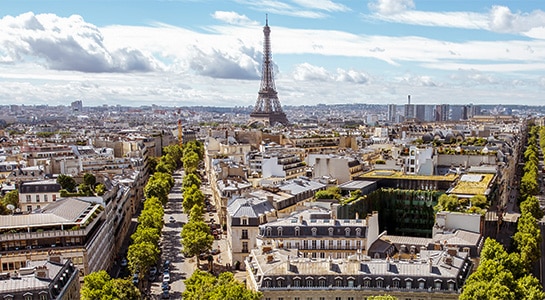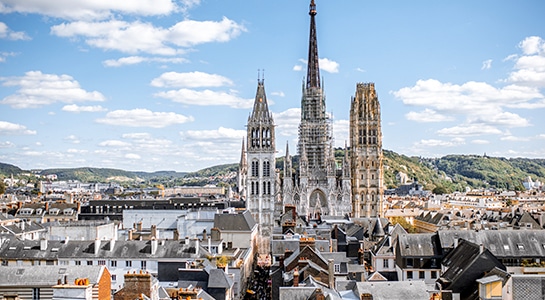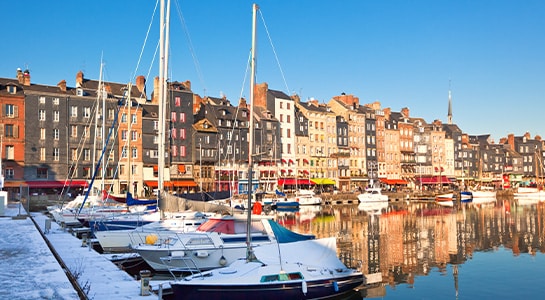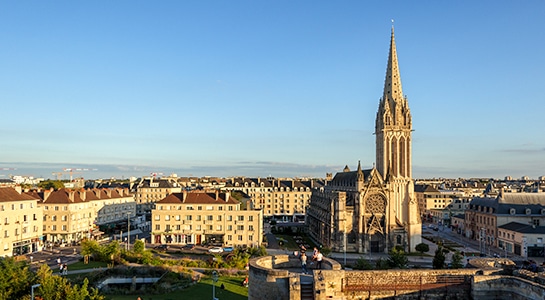Normandy Road Trip from Paris
Enjoy a picturesque trip through Normandy from Paris
From the iconic sights of Paris to the historic streets of Caen, our Normandy road trip takes in an abundance of cultural and gastronomical delights. Immerse yourself in local history, hike through rolling countryside, or visit some of the many charming coastal villages linked to the D-Day landings as you journey through this spectacular area rich in history.
Route
Paris ➤ Rouen ➤ Honfleur ➤ Caen
Distance
Approx. 165 miles / approx. 3 hours
Travel duration
4 days
Highlights
Eiffel Tower, Notre Dame, Musée des Beaux-Arts, Vieux Bassin, Marais Vernier Nature Reserve, Château de Caen
Best time to travel
May to September
Tolls
Motorway tolls are calculated based on the distance travelled and are payable at toll stations. Tunnels and bridges also incur charges.
Day 1 - Paris

With its impressive travel connections from the UK by air, rail or boat, we recommend starting your road trip through Normandy in Paris. With just a day in the city, we suggest exploring the city’s most famous sites with a cruise along the River Seine, visiting the iconic Notre Dame Cathedral and marvelling at works of art in the Louvre. Come nighttime, sample classic French cuisine in one of the city’s many Michelin-star restaurants, experience the splendour of the Eiffel Tower all lit up or enjoy the revelry of the Moulin Rouge.
Sights along the way
- Eiffel Tower: The most famous landmark of the city is a must-visit offering an impressive view over Paris.
- Louvre: The Louvre is one of the largest art museums in the world, best known for housing Leonardo Da Vinci’s Mona Lisa.
- Notre Dame: Considered one of the finest examples of French Gothic architecture, the Notre Dame is home to many religious and historical artefacts, including the Crown of Thorns, believed to have been worn by Jesus Christ during his crucifixion.
- Montmartre and Sacré-Cœur: The home of colourful artists and nightclubs in the 19th Century, the Montmartre remains a charming artistic hub with impressive views overlooking the city.
Gastronomy
Best restaurants in Paris
- Datil
- La Coupole
- Brasserie du Drugstore
- Maison
Local cuisine
- La Poule Au Pot
- Bouche
- Pommes d’Epices
Day 2 - Rouen

Day two of your Normandy road trip starts with a short hour-and-a-half drive to the historic city of Rouen, the capital of Normandy, also known as the ‘city of 100 spires.’ As well as an impressive number of historic churches, the city offers you the chance to visit the cathedral that inspired some of Monet’s paintings, stand at the site where Joan of Arc met her tragic end and visit the birthplace of iconic French novelist Gustave Flaubert.
Sights along the way
- Rouen Cathedral: Rouen’s very own Notre Dame is another impressive example of Gothic architecture but tends to be less crowded than its Parisian counterpart.
- Gros-Horloge: An admirable astronomical clock from the 14th century that is believed to be the oldest clock mechanism in Europe.
- Jardines des Plantes: If you enjoy exploring parks and gardens then this is a must-visit, boasting an impressive collection of plant species from around the world.
- Musée des Beaux-Arts: If you’re in the mood for a museum visit, this art museum features sculptures and paintings by some of France’s most beloved artists including Monet, Delacroix, and Renoir.
- Tour Jeanne d’Arc: This historic tower is the only remaining piece of the mediaeval Rouen castle where Joan of Arc was held captive before her tragic fate in 1430.
Gastronomy
The best restaurants in Rouen
- La Couronne
- Pagani
- Brasserie du Drugstore
- La Maison Turque
Local cuisine
- Tandem
- Simone
- Pommes d’Epices
Day 3 - Honfleur

Day three of your road trip allows you to explore the Normandy coast in the charming fishing village of Honfleur. As quaint fishing villages go, they don’t get much prettier with colourful half-timbered houses jostling for position along the quays with art galleries, shops selling regional wares and local restaurants. Once famous for being a hotspot for impressionist artists, you can still while away an hour or two watching artists at work today.
Sights along the way
- Vieux Bassin: The old harbour of the town is a popular photo spot, famous for its picturesque half-timbered houses and sailboats.
- La Lieutenance: The home of the French king’s lieutenant up until the 17th century, you can admire the remnants of the old city walls.
- Church of Sainte-Catherine: Built entirely of wood in the 15th century by shipwrights it is an architectural marvel and the largest of its kind in France.
- Naturospace: An equatorial zoological garden that is home to an impressive array of tropical plants, birds and butterflies.
- Marais Vernier Nature Reserve: If you’re ready to escape the bustle of town, just outside Honfleur, this nature reserve is the perfect place for seeking tranquillity. Enjoy bird watching or exploring the scenic nature walks.
Gastronomy
The best restaurants in Honfleur
- Le Vieux Honfleur
- Mamie Louise
- Chez Justine Et Quentin
Local cuisine
- L’Escale
- L’art Du Bistrot
- Laurence
Day 4 - Caen

Day 4 of your Normandy road trip involves a short hour’s drive from Honfleur to Caen, the birthplace of William the Conqueror. Situated on the River Orne it is a vibrant and attractive city brimming with fashion boutiques, art galleries and markets selling fine wines and fresh produce so is the perfect place to enjoy all the region’s delicacies. Caen is also the ideal base for exploring the D-Day Landing beaches with guided beach tours available from the city.
Sights along the way
- Château de Caen: Built around 1060 by William the Conqueror, this mediaeval fortress now houses a museum that recounts the rich history of Norman Dukes.
- D-Day Landing beaches: Gold, Sword and Juno beaches where British and Canadian troops landed on 6th June 1944 to liberate France are just a short drive from Caen.
- Abbaye aux Dames: Explore the exquisite architecture of the Men’s Abbey and Women’s Abbey. These impressive Benedictine monasteries were founded in 1066 by Williams the Conqueror and his wife Matilda, in reparation for their marriage which the Pope had forbidden.
- Jardin des Plantes: Caen’s botanical garden is one of France’s oldest. Admire a diverse range of plant species from around the world and enjoy this sanctuary in the heart of the city.
Gastronomy
The best restaurants in Caen
- Restaurant L’Aromate
- Teesalon L’Okara
- Bœuf & Cow
Local cuisine
- Jo Et Jack
- Mooky’s
- Balthazar
Useful tips for your road trip from Paris to Normandy
Our Normandy road trip itinerary offers an eclectic mix of activities from exploring the bustle of Paris to visiting the D-Day Landing beaches, so it pays to be prepared. Below we’ve put a list of things you should pack for your trip.
Clothing:
- Comfortable daytime clothes
- Light jackets or sweaters for cooler evenings
- Smart casual evening wear for fine dining
- Raincoat and an umbrella
- Comfortable walking shoes
- Swimwear, if you plan to visit a beach or lake
Camping gear:
- Camper accessories
- Sleeping bag or duvet
- Camping chairs and table
- Flashlight and spare batteries
- Camping stove, lighter and gas
- Cooler box
- Picnic blanket
Other essentials:
- Map/ sat nav
- Passport
- Spare change useful for tolls
- Power bank
- Water bottle
- Games and books
- Travel first aid kit
France has strict traffic rules that must be followed. Here are the most important regulations to be aware of before driving through Normandy.
Speed Limits:
For camping vans up to 3.5 tonnes:
- 130 km/h on motorways
- 110 km/h on expressways
- 80km/h on rural roads
- 50km/h in cities
For campers and motorhomes over 3.5 tonnes:
- 110 km/h on motorways
- 100 km/h on expressways
- 80 km/h on other roads
- 50 km/h in cities
Other traffic rules in France:
- Blood alcohol limit: The blood alcohol limit is 0.5g per litre of blood. An exception applies to novice drivers (within three years of obtaining their licence), where the limit is 0.2g per litre of blood.
- Blind spot: All vehicles weighing more than 3.5 tonnes must display a warning sticker for blind spots. You can easily find these stickers online or at French petrol stations.
- Parking: Parking zones are marked in white, blue, and yellow. A white dashed line indicates where parking is allowed. A blue line indicates parking with a disc. A yellow marking indicates no parking or stopping. Pay special attention to yellow lines, where parking is strictly prohibited.
- Height Restrictions: Always observe height restrictions. Many car parks and supermarkets are not suitable for high campers.
Across France, there are strict rules for camping that you must follow:
- Wild camping is mostly prohibited throughout the country, especially in nature reserves, along the coast, or near landmarks. Plan to stay at official campsites or designated areas by using our roadspots app.
- Respect quiet hours and environmental considerations. Avoid making noise and ensure you leave no waste behind.
- If you feel tired while driving, you are permitted to spend a night on a roadside or in parking lots to prevent accidents. However, pay close attention to signs strictly prohibiting overnight stays.
- You may only camp on private property with the owner’s permission.
- Overnight stays or stopping at motorway service areas are allowed for a maximum of 24 hours. However, it’s best to avoid this due to theft warnings from the Foreign Office.
- Never leave valuables or luggage in your camper unattended. It’s best to park in a video-monitored car park or a guarded parking lot.













_7.png)



_1.png)

